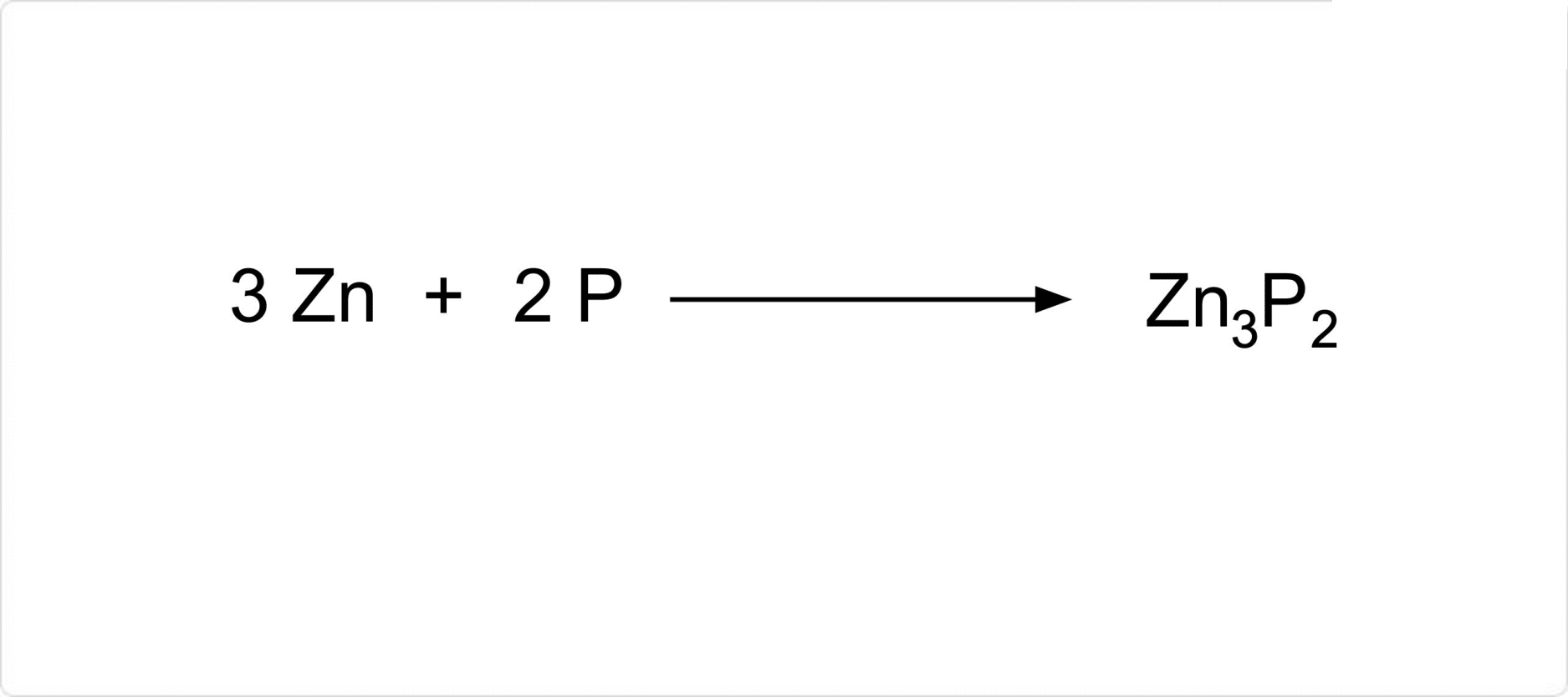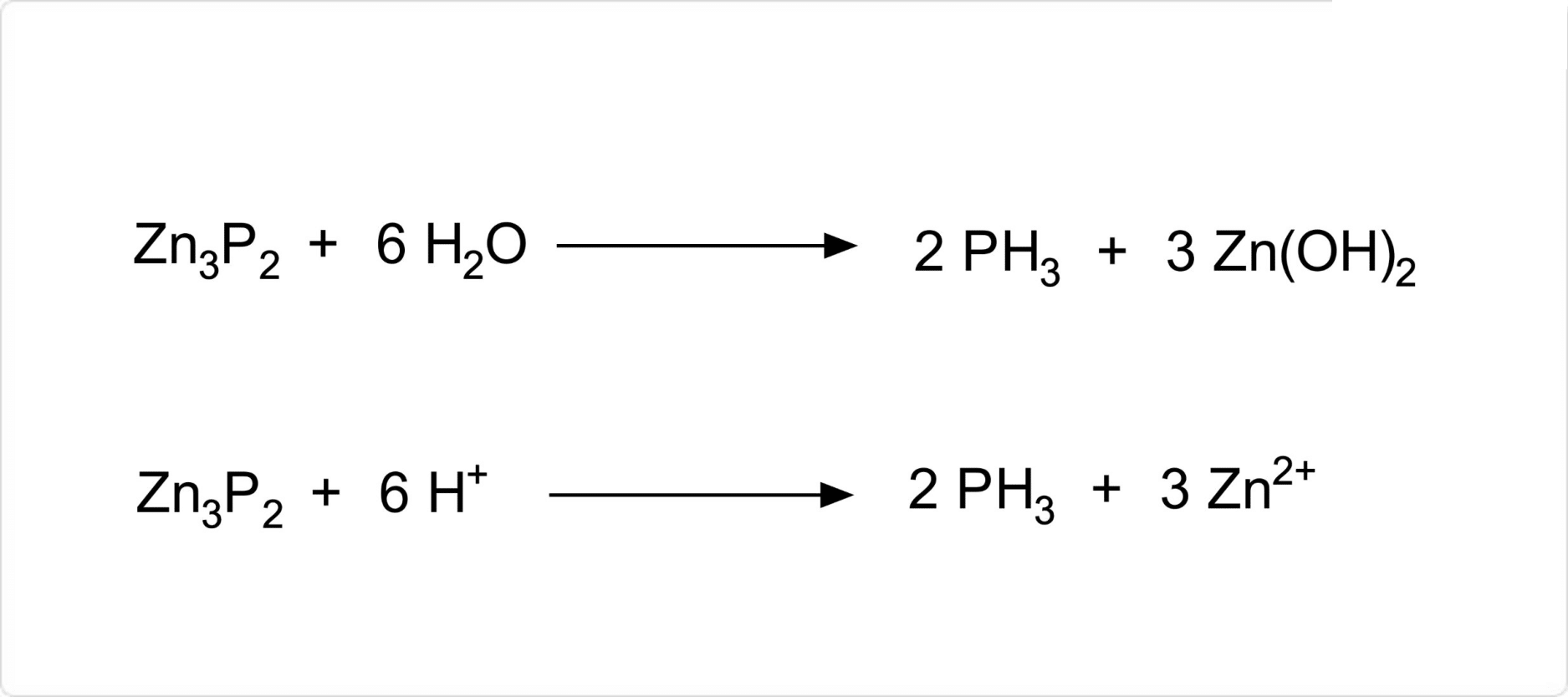リン化亜鉛 化学特性,用途語,生産方法
種類
リン化亜鉛は主に研究開発用試薬製品や、産業用無機化合物材料として一般に販売されています。通常、室温で取り扱い可能な試薬製品として扱われます。
産業用無機化合物材料としては、殺鼠剤などの原料の他、太陽光発電セル材料などを想定して販売されています。
性質
リン化亜鉛は、分子量258.1、融点420℃、沸点1,100℃であり、常温では暗灰色の固体または粉末です。
密度は4.6g/mLであり、水に対して溶解せずに徐々に分解する性質があります。それ以外では、二硫化炭素及びベンゼンに微溶であり、アルコールには殆ど溶けません。不燃性の物質です。
解説
リン化亜鉛 (英:Zinc phosphide) とは、組成式Zn3P2で表される、リンとから構成される無機化合物です。
別名では、ニリン化三亜鉛 (英: Trizinc diphosphide)とも表記されます。CAS登録番号は、1314-84-7です。
合成

リン化亜鉛の合成
リン化亜鉛は、リンと亜鉛を反応させることで合成することが可能です。その他の合成方法としては、トリ-n-オクチルホスフィンとジメチル亜鉛との反応があります。
説明
Zinc phosphide, trizinc diphosphide, is an amorphous gray-black
powder with a garlic-like odor. It is practically insoluble
in water (decomposes slowly), ethanol, slightly soluble in
carbon disulfide, and benzene [9, p. 967].
Zinc phosphide is produced by heating finely powdered
zinc with phosphorus (10).
化学的特性
Zinc phosphide is a gray crystalline solid.
使用
Zinc phosphide has been used since the second world war, and is most commonly used as an effective insecticide and rodenticide. Zinc phosphide is highly toxic due to its production of phosphine gas, and can cause symptoms such as nausea, vomiting and dyspnea in those (animal or human) that are exposed.
一般的な説明
ZINC PHOSPHIDE is a dark gray granular solid. ZINC PHOSPHIDE is slowly decomposed by water giving off phosphine, a flammable poison gas. ZINC PHOSPHIDE is toxic by ingestion. ZINC PHOSPHIDE is used in medicine and as a rat poison.
反応プロフィール
ZINC PHOSPHIDE is a reducing agent. They slowly generate flammable or noxious gases in contact with water. Phosphides react quickly upon contact with moisture or acids to give the very toxic gas phosphine; phosphides also can react vigorously with oxidizing materials. In general, materials in this group are incompatible with oxidizers such as atmospheric oxygen. They are violently incompatible with acids, particularly oxidizing acids.
健康ハザード
ZINC PHOSPHIDE is very caustic when ingested. ZINC PHOSPHIDE reacts with water and acid in the stomach and causes severe irritation. The probable oral lethal dose is 5-50 mg/kg, or between 7 drops and 1 teaspoonful for a 70 kg (150 lb.) person. Most patients die after about 30 hours from peripheral vascular collapse secondary to the compound's direct effects. Extensive liver damage and kidney damage can also occur. Ingestion of 4-5 grams has produced death in human adults, but also doses of 25 to 50 grams have been survived. The lowest oral lethal dose reported for women is 80 mg/kg.
火災危険
When heated to decomposition, ZINC PHOSPHIDE emits toxic fumes of phosphorus and zinc oxides. Irritating oxides of phosphorus may be formed in fires. May ignite in presence of moisture. Contact with water produces flammable gas. Runoff to sewer may create fire or explosion hazard. Decomposed slowly by water giving off phosphine, a flammable poison gas. Reacts violently with concentrated sulfuric acid, nitric acid, and other oxidizing agents. Reacts with hydrochloric acid or sulfuric acid with the evolution of spontaneously flammable phosphine. May ignite in the presence of moisture, or evolve flammable gas. Stable unless exposed to moisture; toxic phosphine gas may then be released and collected in closed spaces. Hazardous polymerization may not occur.
化学反応

リン化亜鉛の化学反応
リン化亜鉛は、水と反応してリン化水素ガス () と水酸化亜鉛に分解します。また、前述の通り、酸と反応して亜鉛イオンとリン化水素ガスを生じます。このリン化水素ガスは、無色の悪臭がするガスで、強い毒性を有する物質です。そのため、リン化亜鉛の取り扱いや保存には、注意が必要です。
リン化亜鉛は、加熱によっても分解し、リン酸化物や亜鉛酸化物などの有毒で引火性のヒューム及びホスフィンを生じる物質です。また、強酸化剤とも激しく反応し、火災の危険を生じるとされています。強酸化剤、酸、水は、リン化亜鉛の取り扱いにおいて混触危険物質に指定されています。
有害性と法規制情報
リン化亜鉛は前述の通り、分解によって有害なリン化水素ガスを生じる物質です。人体への有害性として、以下が挙げられます。
- 飲み込むと生命に危険
- 強い眼刺激
- 中枢神経系、呼吸器、肝臓、腎臓、血液系の障害
- 長期にわたる、又は反復ばく露による中枢神経系、腎臓、血液系の障害
- 長期にわたる、又は反復ばく露による肝臓の障害のおそれ
また、 リン化水素ガスはリン化亜鉛が水に触れると発生しますが、可燃性の気体です。これらの有害性により、毒物及び劇物取締法では劇物に指定されています。
消防法では、「 第3類自然発火性物質及び禁水性物質、金属のリン化物」「貯蔵等の届出を要する物質」に指定されている物質です。その他、道路法、航空法、船舶安全法、港則法、水道法、下水道法、大気汚染防止法、水質汚濁防止法などでも制限を受けています。
参考文献
使用用途
リン化亜鉛の主な使用用途は、殺鼠剤や殺虫剤です。一般的には、家ネズミや野ネズミの駆除に用いられています。ニュージーランドにおいては、フクロギツネの駆除にもペースト剤が利用されている他、ポプラのヤナギシリジロゾウムシに対する殺虫剤としても使用されている物質です。
リン化亜鉛の殺鼠剤としての作用のメカニズムは、リン化亜鉛がネズミの胃酸と反応して、毒性の強いリン化水素ガス (ホスフィン) を生じることによります。この時生じるリン化水素ガスは、中枢神経を侵して呼吸困難を引き起こし、ネズミを死滅させる効果があります。それ以外の産業用用途では、太陽光発電セルに用いられる場合があります。
农业用途
Rodenticide: A U.S. EPA restricted Use Pesticide (RUP).
Registered for use in EU countries
. Zinc phosphide reacts with the acidic conditions in the gut to form phosphine
gas, which interferes with cell respiration. The rodenticide
may be used to control many species of rodents, including mice, ground squirrels, prairie dogs, voles, moles, rats,
muskrats, nutria and gophers. It may be used as an indoor
or outdoor spot treatment for rodents as well as around
burrows or underground in orchards, vineyards, various
food crops, range lands, and non-crop areas. Zinc phosphide is formulated as a bait/solid, dust, granular, pellet/
tablet or wettable powder and is also applied as a broadcast
treatment by ground or aerial applications.
製品名
BAKER BRAND®[C]; BLUE-OX®; E-Z
FLO®[C]; GOPHA-RID®; HOPKINS®; KILRAT®;
MOLETOX II®; MOUS-CON®; MR. KILL RAT®;
MR RAT GUARD®; NOTT ZINC PHOSPHIDE 93®;
RATOL®; ROBAN II AG®[C]; RUMETAN®; ZINC-
TOX®; ZP®
安全性プロファイル
Human poison by
ingestion causing nausea, vomiting, death.
Flammable when exposed to heat or flame.
This material is stable while kept dry. In
moist air, it decomposes slowly. Reacts
violently with acids or acid fumes to emit
the hghly toxic and flammable phosphine.
Violent reaction with concentrated sulfuric
acid, nitric acid, and oxidzing materials.
Incompatible with HCl, H2SO4. When
heated to decomposition it emits toxic
fumes of POx and ZnO. Used as an acute
rodenticide. See also PHOSPHIDES and ZINC COMPOUNDS.
職業ばく露
It is used as an acute single feeding
rodenticide.
輸送方法
UN1714 Zinc phosphide, Hazard Class: 4.3;
Labels: 4.3-Dangerous when wet material, 6.1-Poisono us
materials.
不和合性
Dust may form explosive mixture with
air. Heat and contact with water causes decomposition,
producing toxic and flammable fumes of phosphorus,
zinc oxides; and toxic and flammable phosphine gas.
Reacts violently with strong acids, including nitric,
hydrochloric acid or sulfuric acid with the evolution of
spontaneously flammable phosphine gas. Incompatible
with oxidizers (chlorates, nitrates, peroxides, permanganates,
perchlorates, chlorine, bromine, fluorine, etc.);
contact can cause fires or explosions. Keep away from
alkaline materials, strong bases. carbon dioxide, halogenated
agents.
廃棄物の処理
Consult with environmental
regulatory agencies for guidance on acceptable disposal
practices. Generators of waste containing this contaminant
(≥100 kg/mo) must conform to EPA regulations governing
storage, transportation, treatment, and waste disposal.
Vanadium pentoxide may be salvaged or disposed of in a
sanitary landfill.
リン化亜鉛 上流と下流の製品情報
原材料
準備製品